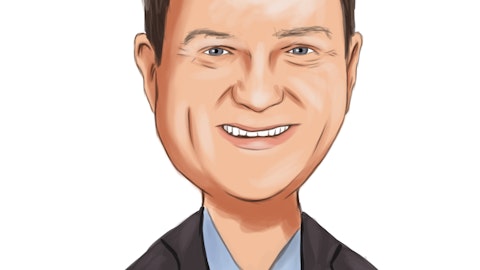Mike Baur: Thank you.
Steve Jones: Thank you.
Operator: One moment for our next question. Our next question comes from Jake Norrison with Raymond James. Your line is open.
Jake Norrison: Thanks for taking my question. A two-parter from me. Firstly, I’m hoping you guys could double-click on the guidance and what that embeds in terms of Intelisys performance. And then if you could double-click on the sort of pricing strategy around Intelisys, and if you could provide more color on if you are still pricing for market share gains and what should we expect there for fiscal ’24?
John Eldh: Yeah, Jake. Thanks for the question. When we look at Intelisys for FY ’24, we are expecting a 7% growth rate on that business.
Jake Norrison: Okay. Perfect. And then if you guys could just provide color on the sort of mix of larger and smaller deals in the quarter and if that had any impact on margin? Thank you.
John Eldh: Yeah, Jake. We saw a — we saw, as you can imagine, a slowdown of our larger deals in the quarter, but we actually saw kind of a positive bounce-back of our run rate business in the quarter.
Jake Norrison: Perfect. That’s all from me. Thank you.
Operator: Thank you. [Operator Instructions] One moment for our next question. And we have a follow-up from the line of Greg Burns with Sidoti. Your line is open.
Greg Burns: I just wanted to ask about the Logitech relationship that you, I guess, entered into this quarter or recently. How does that typically work when you add a new vendor to your line card? Does it take a while for that to ramp-up? Do you expect that to be meaningful to your 2024 revenues? Thanks.
John Eldh: Yeah, Greg. Thanks for the question. We are very excited about the addition of Logitech to our portfolio. It’s going to be a great fit for us in the collaboration space and communications. And it’ll ramp over time, but we’re expecting a positive contribution throughout the year.
Greg Burns: Okay.
Steve Jones: Hey, Greg. This — yeah, hey, Greg. This is Steve Jones. I just wanted to clarify something. I think when you ask me about net interest expense, were you thinking Interest expense less the interest income that we would have as we reconcile or are you thinking about from our EBITDA?
Greg Burns: Interest expense less income.
Steve Jones: Okay. Let — yeah, let me just clarify. So that’ll be around $9 million to $10 million, not the $5 million to $6 million.
Greg Burns: Okay. Yeah. That makes more sense. Thank you.
Steve Jones: Okay.
Operator: One moment for our next question. And we have a follow-up from the line of Keith Housum with Northcoast Research. Your line is open.
Keith Housum: Just one more question for you guys. I mean, working capital, perhaps, Steve, you can walk us through, I guess, the challenges in working down your working capital. I got to believe that accounts receivable is easier to work down than inventory. But maybe you can walk us through some of the challenges in doing that in just a few months or a few quarters and how should we think about it going throughout the year?
Steve Jones: Yeah, Keith. This is Steve. Let me just kind of — let me kind of break it down between inventory and accounts receivable. I mean, it’s harder on the accounts receivable once you get into certain conditions with your customers to change that. That’s a hard thing to change. So — and when we look at our accounts receivable year-over-year and we look at the growth in the business, we don’t feel like we’re that far off and we felt like our accounts receivable are healthy. We’re going to make some improvements in those in those DSOs, but really our focus is on the inventory levels. If you look at the level of inventory that we’re operating at and now that we’re looking especially at a slow-down in the first half, we’re going to be working, the teams are going to be working supplier by supplier to really reset those and correct where we are, as we come out of the — kind of the supply chain disruption where we were scrambling to get inventory and trying to get orders on the books to a more normalized flow of inventory to support demand.
Keith Housum: Great. Just one follow-up to that. Do you guys have the ability to send inventory back to your vendors or is it just a matter of slowing down your purchases, as you sell lot more?
Steve Jones: We do have the ability to rebalance our inventory, and so that keeps our inventory fresh, but it really is — the bigger lever here is going to be getting our orders in line with the demand going forward and allowing that inventory to cycle out of our warehouse.
Keith Housum: Okay. Thank you.
Mike Baur: Hey, Keith. It’s Mike. If I just add a little more color to the question and answer. Over the years, we’ve always had a really close relationship with all of our suppliers on what is the optimum — optimal amount of inventory that we need to satisfy demand. And what we’re basically saying is, we’ve always been willing to have a slightly more inventory than the market required, but not to the levels we are today. The levels we have today are unprecedented, and that’s primarily because lead times got distorted during the supply chain crisis. That’s over — that crisis is over. And so we believe that our suppliers will understand why we need to match our lead times and inventory levels with demand. And this won’t be a surprise to them, but this is something that we can have an impact on much quicker, as Steve said, than AR.
And we believe that the inventory levels are just unsustainable based on what suppliers want. A supplier doesn’t want to have the amount of inventory they have to date in the channel, because then it gets dated. And back to your question, if something is deemed — if a product is deemed discontinued, we have rights to return all discontinued products. So in that case, suppliers don’t want to have old inventory, because then it’s just like bananas and the stuff goes bad, and they have to take it back contractually. So our goal is to work with our suppliers cooperatively supplier by supplier and find the optimal level of inventory.



